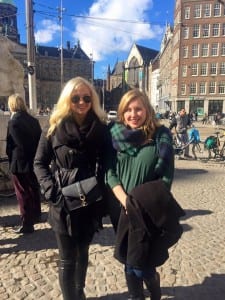
Picture perfect windows in picture perfect canal houses lined with picture perfect flower boxes.
This is what I was lucky enough to experience over Spring Break thanks to SMU and the University Honors Program (UHP). No Destin or Breckinridge for this gal; two weeks ago, I left the United States for the first time, essentially on the Honors Program’s dime. Amsterdam was where I landed.
The trip was a component of the course, “Sexual Minorities and Human Rights,” a UHP course co-taught by a member of the French faculty, Professor Maxime Foerster (who also holds degrees in Gender Studies) and History professor Dr. David D. Doyle. A course designed to take an insightful look into the history of sexual minorities in the United States, Europe and Africa, “Sexual Minorities and Human Rights” is divided into three sections— one for each continent. The beginning of the European section of the course coincided with this midterm trip to what is sometimes called “the world’s most liberal city.”

Amsterdam is a dream. Under slightly cloudy skies I strolled on cobblestone, crossing bridges over the canals in the city, and ate the most delicious and buttery pancakes you could possibly imagine. I sniffed tulips at the Bloemenmarket, a stretch of the Singel Canal in the city center. Bicycle wheels spun wildly around me, the row houses stretched on for kilometers. The air was just brisk enough for my Texas bones to be reminded that winter had yet to begin.
It was almost utterly picturesque. But where the idyllic ended, the education began.
My classmates, professors, and I (a group of fourteen in total) were lucky enough to take on the Dutch perspective of the topics we had been discussing for seven weeks. On the topic of sexuality, we spent an entire evening in the Red Lights District, touring with former sex worker and current activist for sex worker’s rights, Mariska Majoor, founder of the Prostitution Information Center located directly behind the Oude Kerk, Amsterdam’s oldest building and church. It was incredibly eye-opening experience to gain insight into the legal practice of sex work in Holland.
Also in the realm of our gender and sexuality topics was a day trip out to Rotterdam, to visit a non-profit community center specifically for LGBT youth in the heart of that incredible urban hub. This center, called The Hangout 101, was founded by Gert-Jan Vanboom, a hilarious man who welcomed us with jokes and warmth, but also information on the role being LGBT plays in being both a Dutch citizen, and also being a refugee in the Netherlands. We dined and spoke with LGBT refugees to Holland from Egypt, Armenia, and Jamaica, who told us their personal stories of persecution and immigration.
For the Human Rights perspective of our course, our group was also lucky to experience The Hague, the political capital of Holland. The Peace Palace, where the Nuremberg Tribunal of Post-World War II was held, was one of our stops, as well as a unique location called Humanity House. This was an interactive experience, where visitors take on the role of refugee in a educational simulation. It was an incredibly humbling experience, to feel the fear and anxiety that comes with seeking asylum.
Back in Amsterdam, between incredible lectures and educational field trips and pancakes, we were able to a number of other excursions. I walked through the Anne Frank House and saw where she had spent so many months in hiding before her deportation to Auschwitz. The art history major in me was moved at the Rembrandt home, the Rijksmuseum, and most of all, the masterpiece of an institution that is the Van Gogh Museum.

I was so incredibly lucky to get to learn and explore in Europe this Spring Break through SMU’s University Honors Program, with some of SMU’s brightest students and most dedicated faculty. My heart feels as full as the stalls and stalls of tulip shops, bursting with color and energy, now that I’ve had such an eye-opening experience.
-Blair Betik
